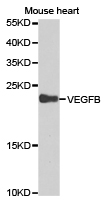VEGFB Rabbit Polyclonal Antibody
Frequently bought together (3)
Transient overexpression lysate of vascular endothelial growth factor B (VEGFB)
USD 396.00
Other products for "VEGFB"
Specifications
| Product Data | |
| Applications | ICC/IF, WB |
| Recommended Dilution | WB 1:500 - 1:2000 |
| Reactivities | Human, Mouse, Rat |
| Host | Rabbit |
| Isotype | IgG |
| Clonality | Polyclonal |
| Immunogen | Recombinant protein of human VEGFB |
| Formulation | Store at -20C or -80C. Avoid freeze / thaw cycles. Buffer: PBS with 0.02% sodium azide, 50% glycerol, pH7.3 |
| Concentration | lot specific |
| Purification | Affinity purification |
| Conjugation | Unconjugated |
| Storage | Store at -20°C as received. |
| Stability | Stable for 12 months from date of receipt. |
| Gene Name | vascular endothelial growth factor B |
| Database Link | |
| Background | Vascular endothelial growth factor (VEGF) is a highly specific mitogen for vascular endothelial cells. VEGF and its close relatives VEGF-B, -C and -D form a subfamily within PDGF family of growth factors, which belongs to the cysteine knot class of cytokines. Five VEGF isoforms of 121, 145, 165, 189 and 206 amino acids (VEGF121¨C206) are generated as a result of alternative splicing from a single VEGF gene.The various VEGF forms bind to three tyrosine-kinase receptors, VEGFR-1, VEGFR-2 and VEGFR-3 which are expressed almost exclusively in endothelial cells. VEGFR-2 is the main angiogenic signal transducer for VEGF, while VEGFR-3 is specific for VEGF-C and -D and is necessary and sufficient for lymphangiogenic signaling. However, upon proteolytic processing VEGF-C and -D gain the ability to also bind and activate VEGFR-2. Guided by the binding properties of the ligands, the VEGFRs are able to form both homodimers and heterodimers. Receptor dimerization is accompanied by activation of receptor kinase activity leading to receptor autophosphorylation. Phosphorylated receptors recruit interacting proteins and induce downstream signaling . Recently, tumor therapies based on neutralizing anti-VEGF antibodies and small molecule tyrosine kinase inhibitors targeting VEGFRs have been developed. These new strategies for tumor treatment show the clinical relevance of inhibiting VEGF signal transduction pathways that are exaggerated in pathological angiogenesis . |
| Synonyms | VEGFL; VRF |
| Reference Data | |
| Protein Families | Druggable Genome, Secreted Protein |
| Protein Pathways | Bladder cancer, Cytokine-cytokine receptor interaction, Focal adhesion, mTOR signaling pathway, Pancreatic cancer, Pathways in cancer, Renal cell carcinoma |
Documents
| Product Manuals |
| FAQs |
| SDS |
{0} Product Review(s)
0 Product Review(s)
Submit review
Be the first one to submit a review
Product Citations
*Delivery time may vary from web posted schedule. Occasional delays may occur due to unforeseen
complexities in the preparation of your product. International customers may expect an additional 1-2 weeks
in shipping.






























































































































































































































































 Germany
Germany
 Japan
Japan
 United Kingdom
United Kingdom
 China
China



